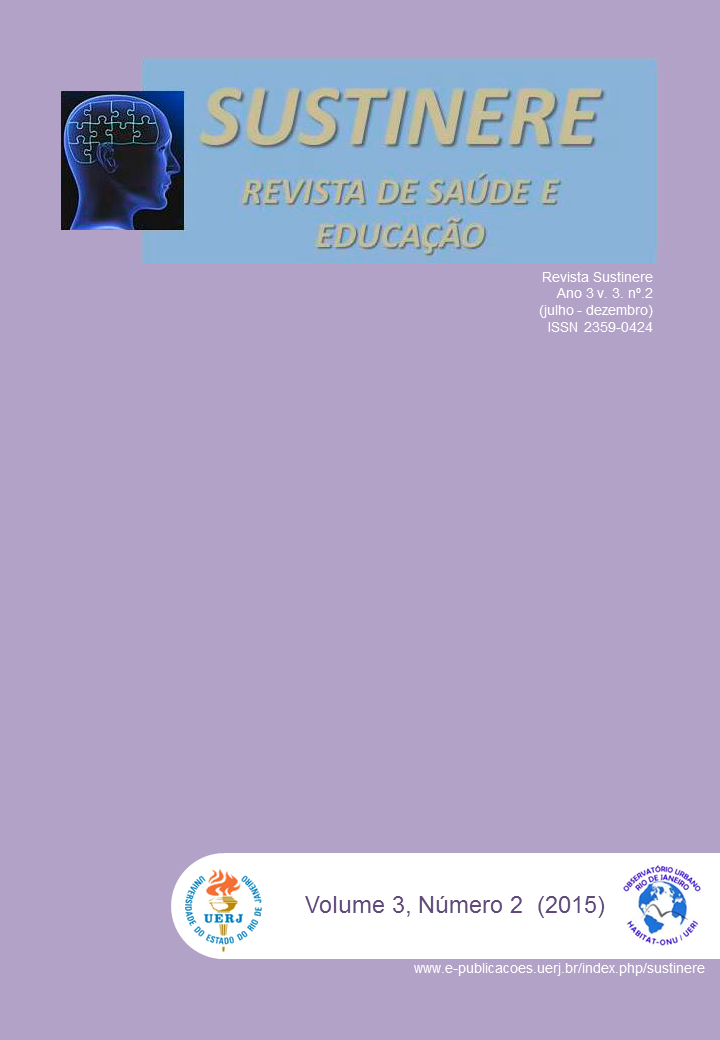Avaliação pós-ocupação do Pavilhão prof. Antônio Fernando Rodrigues (UERJ) a partir da satisfação dos usuários
DOI:
https://doi.org/10.12957/sustinere.2015.20004Palavras-chave:
Avaliação Pós-Ocupação, Satisfação dos usuários, Poema dos desejosResumo
A Avaliação Pós-Ocupação (APO) é caracterizada como um conjunto de métodos e técnicas que possibilitam o diagnóstico de pontos positivos e negativos de qualquer ambiente construído no decorrer do seu uso. Esse processo se destaca por levar em consideração a satisfação dos usuários no atendimento de suas necessidades. Foi realizada uma APO no Pavilhão Prof. Antônio Fernando Rodrigues do campus Maracanã da Universidade do Estado do Rio de Janeiro (UERJ), em relação a qualidade ambiental, a partir do grau de satisfação de seus usuários. Dados da avaliação do grau de satisfação dos usuários mostraram tendência positiva em iluminação artificial, ventilação artificial, temperatura no inverno, temperatura no verão e iluminação natural. Constatou-se, de maneira geral, que os usuários consideram a edificação bem iluminada, climatizada e dimensionada, porém carece de melhor isolamento acústico. A análise realizada gerou recomendações de melhorias em conforto ambiental e funcionalidade deste ambiente. Estas podem contribuir no aprimoramento para futuros projetos, evitando a repetição de inadequações e, consequente, insatisfações dos usuários, além de melhor gestão pós-ocupação.
DOI: http://dx.doi.org/10.12957/sustinere.2015.20004
Referências
BERTOLINI, H. O. L. Construção via obras secas como fator de produtividade e qualidade. Trabalho de Conclusão de Curso (Graduação). UFRJ / Escola Politécnica, Rio de Janeiro, 2013. 87pp. Disponível em <http://monografias.poli.ufrj.br/monografias/monopoli10007921.pdf> Acesso em 22/10/2015
HADJRI, K.; CROZIER, C. Post-occupancy evaluation: purpose, benefits and barriers. Facilities, s.l. v.27, n.½, p.21–33,. 2009. Disponível em: <http://www.emeraldinsight.com/doi/abs/10.1108/02632770910923063> Acesso em: 28/09/2015.
KOWALTOWSKI, DORIS C. C.; GRANJA, A.D.; MOREIRA, D. C.; DA SILVA, V.G.; MIKAMI, S.A.; PINA, G..Métodos e instrumentos de avaliação de projetos destinados à habitação social in : Qualidade Ambiental na Habitação: Avaliação Pós-Ocupação org. VILLA B. S. ; ORNSTEIN S. W.. Departamento de Arquitetura e Construção da Faculdade de Engenharia Civil, Arquitetura e Urbanismo da Universidade Estadual de Campinas, FEC/UNICAMP . Cap.2.7; Editora Oficina de Textos, SP, 400pp. 2013. Disponível em <http://www.dkowaltowski.net/wp-content/uploads/2014/07/Kowaltowski-et-al-metodos-e-instrumento.pdf> Acesso em 15/10/2015
LIMA, M. B.; MONTEIRO, F.; MARINHO, J.; FERREIRA, J.; MACENA, T.. Avaliação Pós Ocupação em um Instituto Federal de Educação: Contribuições para a melhoria do ambiente a partir da percepção dos usuários. . Anais do Congresso Norte e Nordeste de Pesquisa e Inovação 2012, Palmas, v.1. Palmas, 2012 Disponível em <http://propi.ifto.edu.br/ocs/index.php/connepi/vii/paper/viewFile/5336/2942> Acesso em 20/10/2015
LUNA, V. L.; ARAÚJO, N. M. C.. Avaliação pós-ocupação aplicada a uma Delegacia de Polícia Civil: um estudo de caso quanto à satisfação dos usuários. Anais do XII ENTAC - Encontro Nacional de Tecnologia do Ambiente Construído, 2008. Fortaleza, 2008. Disponível em: <http://www.infohab.org.br/entac2014/2008/artigos/A1779.pdf> Acesso em 15/10/2015
MOREIRA, D. C.; KOWALTOWSKI, D.C.C.K.. Discussão sobre a importância do programa de necessidades para a qualidade no processo de projeto em arquitetura. Revista Ambiente Construído. Porto Alegre, v. 9, n.2, p. 31-45, jun 2009. Disponível em: <http://seer.ufrgs.br/ambienteconstruido/article/view/7381> Acesso em 07/12/2015.
PENHA, L. M. O.. Avaliação Pós-Ocupação de duas edificações de Bibliotecas de Instituição de Educação Superior. Trabalho de Conclusão de Curso (Mestrado). Universidade de Brasília. Brasília, 2008. 276p. Disponível em <http://repositorio.unb.br/handle/10482/2083> Acesso em 20/10/2015.
RHEINGANTZ, P.A; AZEVEDO, G.A; BRASILEIRO, A; DE ALCANTARA, D.; QUEIROZ, M.. Observando a Qualidade do Lugar: procedimentos para a avaliação pós-ocupação. Rio de Janeiro: Coleção PROARQ, FAU-UFRJ, 2009. 117p. Disponível em :<http://www.fau.ufrj.br/prolugar/arq_pdf/livros/obs_a_qua_lugar.pdf> Acesso em 15/10/2015
RILEY, M.; KOKKARINEN, N.; PITT, M.. Assessing post occupancy evaluation in higher education facilities. Journal of Facilities Management, s.l.. v. 8, n.3, p.202–213,. 2010. Disponível em: <http://www.emeraldinsight.com/doi/abs/10.1108/14725961011058839> Acesso em: 11/10/2015.
ROMÉRO, M.A.; ORNSTEIN, S.. Avaliação pós Ocupação: métodos e técnicas aplicados à habitação social. Coleção Habitare. Porto Alegre: ANTAC. 294 p. 2003. Disponível em :<http://www.habitare.org.br/publicacao_colecao1.aspx> Acesso em 15/10/2015
SILVA, L. D.. Técnicas e procedimentos para assentamento de alvenaria de vedação e estrutural. Trabalho de Conclusão de Curso (Graduação). Universidade Anhembi Morumbi. São Paulo, 2007. 50p. Disponível em <http://engenharia.anhembi.br/tcc-07/civil-27.pdf> Acesso em 20/10/2015
TURPIN-BROOKS, S.; VICCARS, G.. The development of robust methods of post occupancy evaluation. Facilities, s.l.. v.24 n. 5/6 p. 177 – 196. 2006. Disponível em: http://www.emeraldinsight.com/doi/abs/10.1108/02632770610665775. Acesso em: 02/10/2015.
Downloads
Publicado
Como Citar
Edição
Seção
Licença
Os Direitos Autorais dos artigos publicados na Revista Sustinere pertencem ao(s) seu(s) respectivo(s) autor(es), com os direitos de primeira publicação cedidos à Revista SUSTINERE.
Os artigos publicados são de acesso público, de uso gratuito, com atribuição da autoria original obrigatória, de acordo com o modelo de licenciamento Creative Commons 4.0 adotado pela revista.

A Revista Sustinere está licenciada com uma Licença Creative Commons Atribuição 4.0 Internacional.






